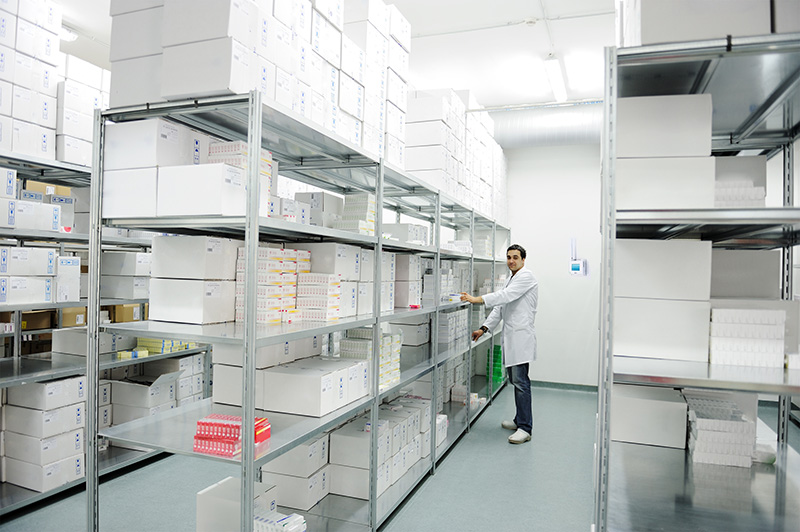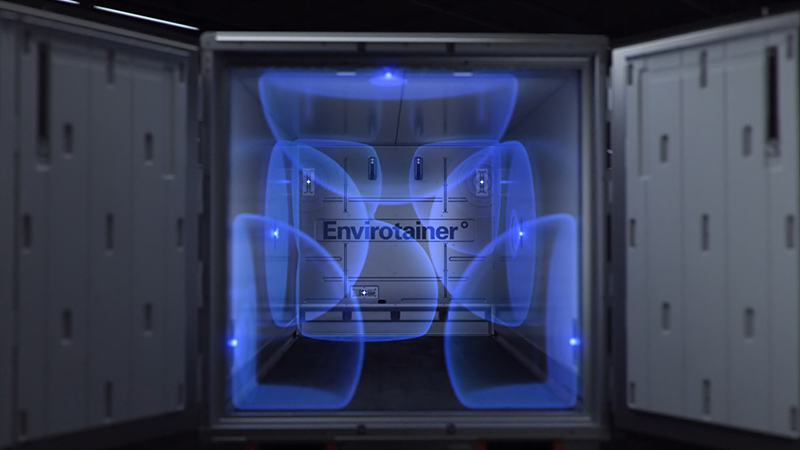Background
Pharmaceutical manufacturers must qualify temperature-controlled storage areas and provide evidence of continuous temperature monitoring in storage areas to regulatory agencies and clients. Temperature mapping, refrigeration equipment maintenance, and the calibration of sensors are also necessary.
Following manufacture, pharmaceutical products generally reach end users through a complex cold chain with multiple stages. It is therefore vital that each stage is monitored accurately and reliably. All parties within the cold chain seek the successful delivery of the product, without harming its quality or integrity. However, the information needed from temperature monitoring devices may differ among parties. For example, the final recipient needs to know if there were any temperature excursions that would require rejection of the shipment, but they may have less interest in the cause of the excursion. Meanwhile, the root cause of the excursion would be the major point of interest for the manufacturer and the logistics service provider. A continuous temperature monitoring system should therefore provide all parties with the information they need.
In common with many other sectors, the pharmaceutical industry has adopted a Quality Risk Management (QRM) approach to the manufacture and distribution of products. The International Council on Harmonization of Technical Requirements for Registration of Pharmaceuticals for Human Use (ICH) defines quality risk management as a ‘systematic process for the assessment, control, communication, and review of risks to the quality of the medicinal product across the product lifecycle’ [1]. This approach was also reflected in regulatory guidance document updates from the United States Pharmacopoeia [2], and the European Commission [3].
Regulations are generally created by national regulatory agencies, other regulatory bodies such as IATA and the ICH, while international organisations such as the WHO create guidelines. Regulatory pressures are strongest at the manufacturer’s end of the supply chain, with comprehensive temperature monitoring being undertaken by drug manufacturers and documented in quality agreements with their downstream supply chain partners.
Examples of national regulatory agencies include the USFDA, the European Medicines Agency and the Medicines and Healthcare Products Regulatory Agency (MHRA) in the UK. These organisations issue guidelines such as the MHRA publication ‘Rules and Guidance for Pharmaceutical Manufacturers and Distributors 2017’ which provides detailed requirements for the calibrated accuracy of temperature monitoring [4].

Temperature control regulations
The USFDA’s Federal Food, Drug, and Cosmetic Act states that a drug is adulterated if the facilities or controls used for its ‘manufacture, processing, packing or holding’ do not conform with Current Good Manufacturing Practice (cGMP) [5]. The term ‘holding’ refers to any way in which a drug is ‘distributed, transported, or warehoused for distribution or transfer.’ Maintaining temperature control is a GMP requirement; if goods are not maintained in specified conditions throughout all stages, they are considered adulterated.
The ICH Q9 ‘Guideline on Good Manufacturing Practices (GMP)’ also requires that manufacturers ensure the transporters of products follow appropriate transport and storage conditions [6].
‘Temperature Control Regulations’ published by IATA cover the shipping of temperature-sensitive products [7]. IATA outlines the importance of temperature monitoring in its ‘Guidance for Vaccine and Pharmaceutical Logistics and Distribution’ [8].
Static temperature monitoring
At various points in the cold chain, pharmaceutical products are static – stored in a warehouse or distribution centre awaiting dispatch. For static stages in the cold chain, a wide variety of monitoring solutions are available to reduce the risk of non-compliance in GxP-compliant holding areas. For example, Vaisala’s viewLinc continuous monitoring system has been continuously developed for over two decades for critical monitoring applications such as pharmaceutical distribution. As such, the viewLinc monitoring platform represents a blueprint for GxP-compliant monitoring because it includes key features designed to meet regulations:
- Real-time monitoring and alarms with customisable reports
- Alarm notifications by email, SMS, voice call, lights and sirens
- Gap-free monitoring (even during power and network outages)
- Intuitive, easy to validate software
- Easy network connectivity via Ethernet, Wi-Fi, or VaiNet wireless technology (over 100m)
- Browser based access for global environmental management
- Simple installation and validation, with optional IQ/OQ protocols
- Optional GxP documentation package for GAMP-style validation
- Reports compliant with 21 CFR Part 11 and EU GMP Annex 11, delivered by email
- Encrypted data and audit trail
- Monitoring data can be shared with other systems via OPC UA & API
- Unlimited parameter integration with Modbus and analog devices
- Intrinsically safe options for hazardous/explosive areas
- ICH-compliant calibration options
One of the most important features of a temperature monitoring system like viewLinc is its ease of use; not only for set-up and operation, but also for user training, system validation, sensor calibration. These features ensure fewer errors, less deviations, and considerable time savings.
The most common measurement parameters are temperature, relative humidity, carbon dioxide, differential pressure, and door contacts. However, this wish-list of features is redundant if the sensors are not accurate, stable, and reliable. This is a fundamentally important aspect of Vaisala technology, because the cost of high-quality sensors is negligible in comparison with the value of the assets and goods that they protect.
Dynamic temperature monitoring
The temperature control of goods in transit can be considered the dynamic part of the pharmaceutical cold chain. Because goods cross borders and use a variety of transport methods, dynamic monitoring is complex. Prior to the COVID-19 pandemic, Envirotainer, a world leader in air-transportation solutions for temperature-sensitive pharmaceuticals, conducted a survey of major stakeholders, including: pharmaceutical companies, airlines, forwarders, and regulators to define current and emerging needs for the airfreight of pharmaceutical products. This survey identified clear needs for shipping containers that were either not currently met, or fully optimised. Based on their analysis of survey results, Envirotainer initiated a product development program that resulted in the 2021 launch of their Releye® RLP container. This new shipping container had an enormous impact in the market, providing fast, reliable deliveries around the world with a wide range of features beyond accurate, verifiable temperature control.
The Releye RLP employs active temperature control, which adjusts the temperature inside the container to maintain the specified temperature range. This monitoring is supported by eight internal Vaisala temperature sensors, one of which also measures humidity. In addition, there are two external Vaisala sensors monitoring ambient temperature and humidity. The Vaisala sensors were chosen for their high performance, long-term measurement stability, low power consumption, and fast response.
Each Releye RLP is supplied with its own rechargeable power supply, so that it is able to operate autonomously for over 170 hours (over a week) without recharging. This is an important feature because these containers ship over continents and can undergo changes of route and delays at customs or during handovers. The ability to maintain effective temperature control during unforeseen delays is therefore a major advantage.
Temperature settings, such as limit values or pre-conditioning, can be managed by an intuitive keypad/screen on the Releye RLP, but users are also able to connect with their containers remotely and securely using any smart device. This live monitoring of position, temperature, battery level, humidity, door openings etc., allows users to continuously track shipment conditions as well as the status of their cargo. Customised alerts can be configured so that users receive early notification prior to cargo arrival, which enables process improvements and delivery planning. This also leads to quicker investigations of risk assessments relating to counterfeit, security concerns or shipment processes.

Conclusion
Pharmaceutical cold chains are complex, with multiple stages in both static and dynamic conditions that increase the risk of non-compliance with global regulations. It is vitally important therefore that accurate, reliable, verifiable monitoring is undertaken at every stage. While technologies for data collection, transmission, processing, and display, have advanced in recent years, the key factors affecting the value of that data, are still the ease with which it can be used and the accuracy/reliability of the sensor.
REFERENCES
1. International Conference on Harmonisation of Technical Requirements for Registration of Pharmaceuticals for Human Use. ICH harmonized tripartite guideline: quality risk management: Q9. 9 November 2005. https://database.ich.org/sites/default/files/Q9%20Guideline.pdf
2. United States Pharmacopeia. Risks and mitigation strategies for the storage and transport of finished drug products (in excerpted USP-NF standards referenced in the USP COVID-19 vaccine handling toolkit). https://www.usp.org/sites/default/files/usp/document/our-impact/covid-19/uspnf-standards-vaccine-handling.pdf
3. European Union. Good Distribution Practice of Medicinal Products for Human Use (2013/C 68/01). https://eur-lex.europa.eu/legal-
content/EN/TXT/?uri=CELEX%3A52013XC1123%2801%29
4. MRHA Rules and guidance for pharmaceutical manufacturers and distributors 2017 (orange guide). 10th ed. London: The Pharmaceutical press; 2017.
5. US FDA. Federal food, drug, and cosmetic act (FD&C act). US code title 21. https://www.ecfr.gov/cgi-bin/text-idx?SID=85f732062d36d1151565dda714602187&mc=true&tpl=/ecfrbrowse/Title21/21tab_02.tpl.
6. ICH Q7 Good manufacturing practice guide for active pharmaceutical ingredients. (2000). https://database.ich.org/sites/default/files/Q7%20Guideline.pdf
7. IATA: Temperature Control Regulations (TCR). 2022 https://www.iata.org/en/publications/store/temperature-control-regulations/
8. IATA: Guidance for vaccine and pharmaceutical logistics and distribution. https://www.iata.org/en/programs/cargo/pharma/vaccine-transport/





